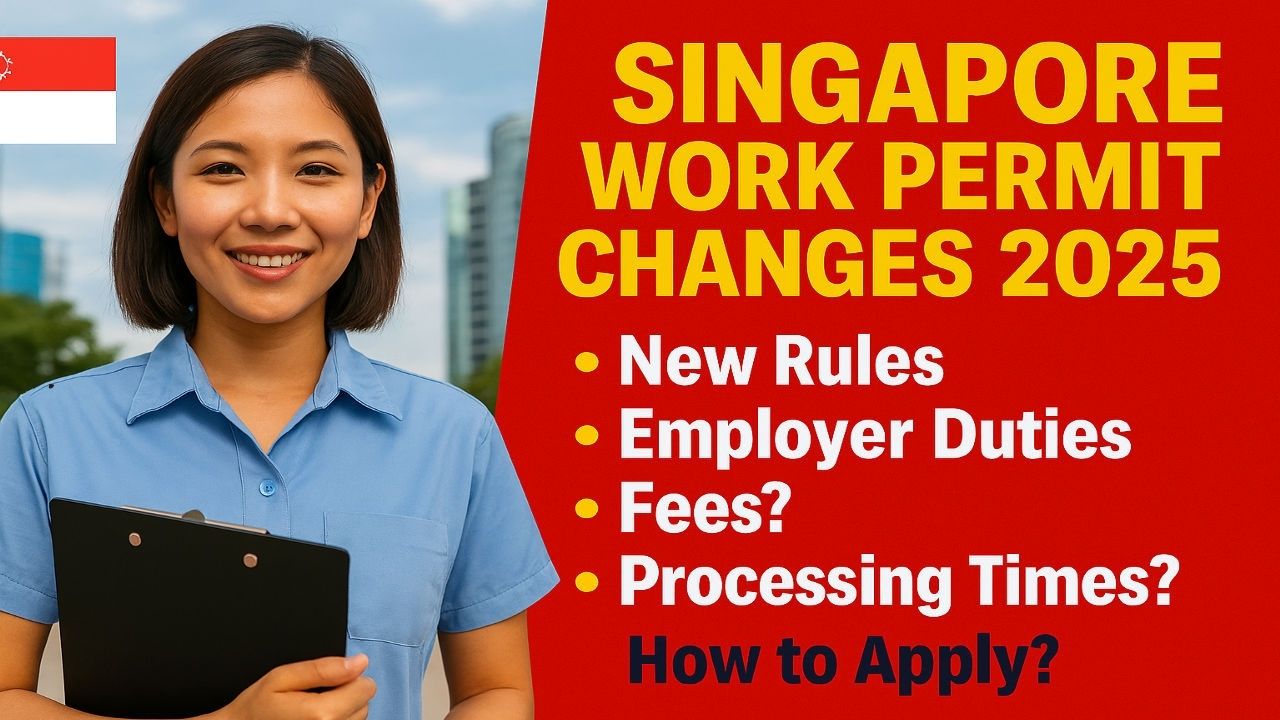A Singapore Work Permit (WP) allows employers to hire foreign workers typically in labour-intensive or specified operational roles within defined sectors such as construction, manufacturing, marine shipyard, process and selected services. The permit sits alongside other passes (for example, S Pass and Employment Pass) and comes with sector-specific quotas, dependency ratios, levy payments, and mandatory insurance.
In 2025, policy adjustments sharpened the balance between local employment priorities and targeted access to foreign manpower. The headline shifts include an upper age limit of 61 for new WP applicants, extended up to 63 for certain current workers who meet sector conditions, and the removal of a fixed maximum stay limit, replacing it with age, eligibility and compliance criteria. At the same time, MOM refined operational processes, digitalised checkpoints, and tightened compliance monitoring to reduce abuse while keeping essential pipelines open for businesses.
Singapore Work Permit Changes 2025 Quick Summary
| Item | Details |
|---|---|
| Authority | Ministry of Manpower (MOM), Singapore |
| Programme | 2025 Singapore Work Permit Changes |
| Who it covers | Foreign workers in specified sectors under the Work Permit regime |
| Key 2025 highlights | Upper age for new WP applicants raised to 61; many existing workers permitted up to 63 in certain sectors; maximum stay cap removed and replaced by age and eligibility checks; Onboard programme durations refined for CMP sectors |
| Employer obligations | Observe sectoral quotas and levies, buy required medical insurance, furnish security bond where applicable, comply with employment terms and housing standards |
| Official site | https://www.mom.gov.sg/ |
Age, tenure and quota rules
- Age eligibility
- New Work Permit applicants must be at least 18.
- The upper age for new applicants is 61 (Malaysian and non-Malaysian), effective mid-2025.
- In selected cases, existing WP holders who meet criteria may continue to work up to 63, depending on sector rules and employer compliance.
- Maximum stay
- The previous hard cap on maximum stay has been removed. Continued employment depends on age limits, ongoing eligibility, satisfactory medical fitness, and full employer compliance with levies, quotas, housing and contractual obligations.
- Dependency ceilings and quotas
- Employers must keep their foreign-to-local ratios within sectoral dependency ceilings. Hiring beyond the ceiling is not allowed; exceeding it after issuance can lead to penalties or non-renewal.
Employer costs and mandatory protections
- Monthly levy
Employers pay a foreign worker levy that varies by sector, sub-sector, skill level and whether the firm is within its quota. For partial months, levies are pro-rated daily. - Security bond
Most non-Malaysian WP holders require a security bond that the employer must purchase and keep valid. Breaches of conditions (for example, illegal deployment, overstaying, unpaid repatriation) can lead to forfeiture. - Medical examinations
Pre-entry and periodic medical checks are required. Employers bear these costs and must ensure workers remain medically fit for duty. - Insurance
Employers must provide medical insurance that covers inpatient, surgical and required primary care, at or above the minimum coverage levels set by MOM. Policies must remain valid throughout the employment period. - Onboard programme (CMP sectors)
For Construction, Marine shipyard and Process sectors, MOM’s Onboard arrangements apply on arrival. As updated, first-time arrivals typically complete a three-day programme; returning workers usually need two days. Employers must book slots in advance and bear associated fees.
What the reforms aim to achieve
- Protect local jobs while filling genuine gaps
Tightened quotas and clearer standards ensure that citizens and residents remain primary beneficiaries of job growth, while businesses can plug critical manpower shortages. - Improve system integrity
Enhanced digital processes, verification, and compliance monitoring help prevent misuse and undercutting, and reduce administrative friction for compliant firms. - Support growth sectors
By adapting age and tenure settings and expanding facilitated schemes (for example, calibrated flexibility under targeted programmes), the framework supports innovation-driven and investment-led employers without compromising fair employment outcomes.
Documents and information employers should prepare
- Company details and business registration
- Quota position and recent levy status
- Worker’s passport particulars, personal biodata and educational or skills documents where relevant
- Security bond arrangement (if required)
- Medical insurance policy reference meeting MOM’s minimums
- Employment contract with compliant terms, including salary, hours, leave, lodging (where applicable) and termination clauses
- For CMP sectors, Onboard booking confirmation
Keep scanned copies ready for upload and ensure all identity details are consistent across documents.
Step-by-step: how to apply for a Work Permit in 2025
- Check quota and eligibility
Verify that your firm is within dependency ceilings and that the role belongs to a sector eligible for Work Permits. - Budget and buy protections
Arrange medical insurance and, for non-Malaysians, the security bond. Ensure accommodation meets required standards where the employer provides housing. - Submit the application online
File the Work Permit application through MOM’s online systems with accurate worker particulars, job details and required declarations. Pay the applicable application fee. - Receive the In-Principle Approval (IPA)
If approved, MOM issues an IPA with conditions and validity dates. Use it for the worker’s entry formalities and to schedule Onboard where required. - Arrival, medical and Onboard
Worker enters Singapore, completes the medical exam and, for CMP sectors, attends the Onboard programme. Keep all receipts and certificates. - Issue the Work Permit
After fulfilling IPA conditions, submit card issuance details, confirm address, contact, and delivery, and book any required biometrics appointment. - Card delivery and compliance
The worker receives the Work Permit card. Employers must then maintain full compliance: pay levies on time, keep insurance active, uphold employment terms, and promptly update MOM on changes (job role, address, loss of card, early termination).
Renewal, transfer and cancellation
- Renewal
Start early. Confirm age, medical fitness, levy and quota status, housing, and insurance validity. Missing any element can delay or block renewal. - Employer or job changes
Transfers usually require a new application and fresh approvals. Do not deploy workers to non-approved locations or roles. - Cancellation
Cancel promptly upon employment end. Arrange repatriation and ensure the Work Permit is no longer active to avoid levy accrual and bond exposure.
Practical tips for employers
- Track your dependency ratio monthly to avoid accidental quota breaches.
- Keep insurance and bond start dates aligned with IPA and arrival timelines to prevent gaps.
- Book Onboard slots as soon as your IPA is issued in CMP sectors.
- Store all receipts, medical results and contracts for audit readiness.
- Use MOM’s digital tools to monitor levy billing, quota usage and permit expiries.
Frequently asked questions
Q1): What is the new upper age limit for new Work Permit applications in 2025?
For new applicants, the upper age is 61. In some sectors, existing workers who meet conditions may continue to 63.
Q2): Did Singapore remove the maximum stay limit for Work Permit holders?
Yes. The fixed maximum stay has been removed. Continued employment now depends on age, ongoing eligibility, and full employer compliance.
Q3): How are levies charged for partial months?
Levies are pro-rated daily for months in which the worker is employed for fewer than the full calendar days.
Q4): Must employers provide health insurance?
Yes. Employers must buy medical insurance that covers inpatient, surgical and primary care at or above MOM’s minimums for all Work Permit holders.
Q5): What is the Onboard programme and who needs it?
In Construction, Marine shipyard and Process sectors, arriving workers attend Onboard for safety orientation and settling-in. As updated, first-time arrivals generally complete three days; returning workers typically do two days.
Q6): Can Work Permit holders bring dependants?
Generally no. Dependants’ privileges apply to higher-tier passes and specific salary thresholds, not to standard Work Permits.
Where do I find official rules and updates?
All authoritative guidance, forms and calculators are on the Ministry of Manpower website.
Official link
- Ministry of Manpower, Singapore: https://www.mom.gov.sg/
Closing note
Singapore’s 2025 Work Permit refinements keep the system practical for employers while protecting local opportunities and raising compliance standards. If you plan to hire under the Work Permit route, map out quota usage, secure insurance and bonds, follow Onboard requirements where relevant, and maintain accurate records from application to card issuance and renewal. Doing these consistently will keep your workforce stable and your firm compliant throughout 2025 and beyond.
For More Information Click HERE





